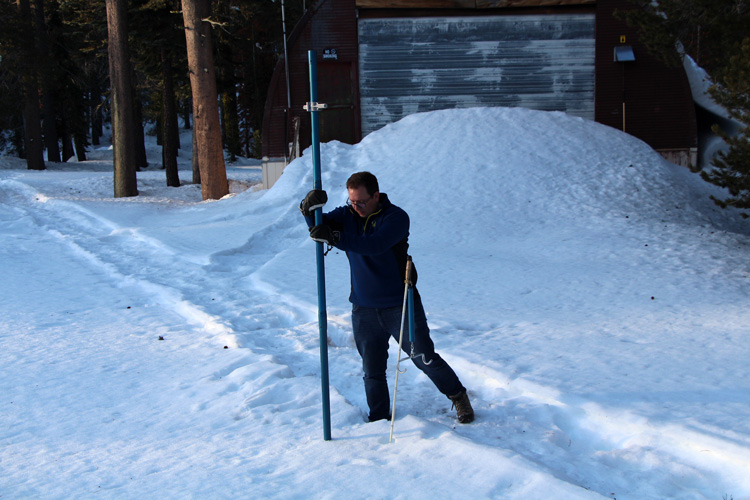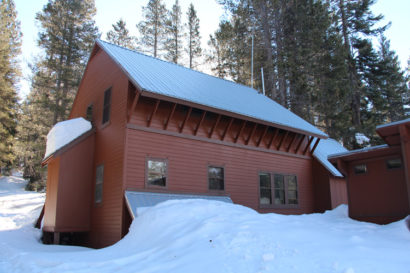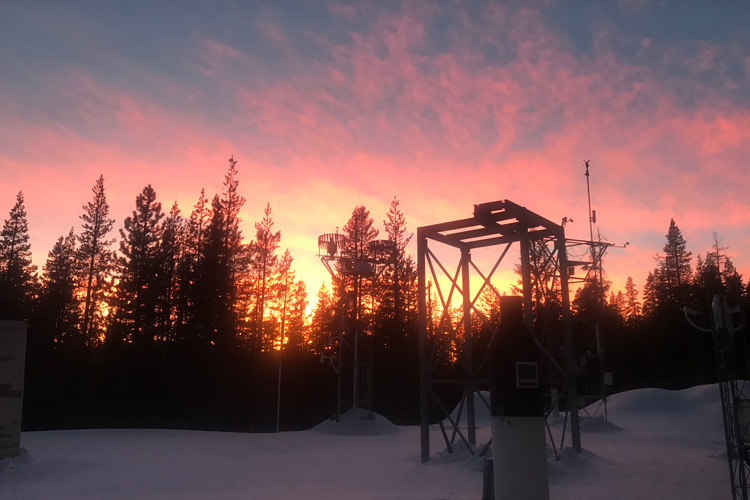With climate change, Berkeley snow lab’s mission remains critical
With records going back 75 years, the Central Sierra Snow Laboratory is a repository of unique data showing the impact of climate change on the state's snowpack and water resources

March 21, 2022
For someone who admits to “childlike excitement” at the prospect of a snowstorm, Andrew Schwartz has the perfect job. He’s the new manager of the University of California, Berkeley’s Central Sierra Snow Laboratory (CSSL), the only continuously manned snow research outpost in the Western U.S.
He arrived there last April, and so far, he’s loving it. His first season in the 75-year-old U.S. Forest Service building — both a lab and a home for him, his wife and two dogs — in Soda Springs, California, saw the second highest October snowfall ever in the Sierra Nevada and the highest snowfall for any December in recorded history.
That was good news at the onset of winter, Schwartz said, but the so-called “whiplash weather” that has become normal in California — unusually dry months followed by abnormally wet months — makes forecasting the season’s snowpack highly uncertain. A lightly dusted January was followed by a nearly dry February, which ended with a 16-inch dump of new snow three weeks ago. Less than 10 inches of snow has fallen since, and predictions are for a drier than normal spring — again.
Because the size of the snowpack determines the water flow into the state’s rivers, streams and reservoirs in the spring — and the water available for agriculture, fish, industry and homes — runoff predictions also are highly uncertain. That means that daily records from CSSL and monthly snow-depth measurements at many other sites in the Sierra Nevada are critical for state and federal water managers who monitor and plan water usage across the West and in California.
“The site is kind of unique in that there’s a lot of the same measurements being made with multiple different instruments,” Schwartz said. “The benefit of having us up here is that during storms, we continue manual measurements. There still isn’t really a unified way of accurately measuring new snowfall, so the best way that we really have is to go out and put a pole in the middle of it and measure it by hand with rulers.”
The intermittently snowy conditions so far this season are perfect for the revitalized role of the lab, which includes testing low-cost, 3D-printed snow depth sensors — prototypes created for water managers in developing countries by the 3D-Printed Automatic Weather Station (3D-PAWS) initiative at the University Corporation for Atmospheric Research (UCAR) in Boulder, Colorado — and testing new instrumentation for the California Department of Water Resources (DWR). These projects help maintain the lab’s prominence in snow science, he said.

The snow lab is testing a 3D-printed snow-depth sensor called 3D-PAWS, which could be used in developing countries to monitor the snow pack and predict future water resources. Schwartz is pointing at two 3D-PAWS sensors mounted on poles behind him. Each device consists of a cone that sends an acoustic signal downward, which bounces off the snow and is received by a sensor. The time between sending and receiving depends on the height of the snow. (Photo by Robert Sanders)
“The snow lab was the pinnacle of snow science for a very long time, and still is, for a large portion of California,” Schwartz said, noting that the lab sits in one of snowiest places in the U.S. “Snow science is more important than it’s ever been, especially in the West, where snow contributes so much to our water resources.”
The lab has an unparalleled record, going back more than 75 years, of daily or even hourly temperature, snowfall and snowpack measurements. While there are several hundred automated snow and precipitation stations throughout the Sierra Nevada, only CSSL has a snow scientist on site to cross-check measurements — there are four different instruments in Schwartz’s backyard that measure precipitation — and provide a measure of the water content in the snow every two to three days.
“We have those long records to look at over the last 75-odd years to really try to determine what the current trends in temperature and precipitation are, compared to some of those stations that might only have a few years of data,” he said.
Snow Lab Hill
Situated on Forest Service land on what locals call Snow Lab Hill, at an elevation of 6,894 feet in Soda Springs, an unincorporated community 10 miles from Truckee, the lab has been a vital, but sometimes mysterious, gem. Schwartz plans to increase its visibility, with outreach to the community and schools and, by making all the snow and precipitation data available online, to the whole world.

Andrew Schwartz, manager of the Central Sierra Snow Laboratory (CSSL) near Donner Summit in the Sierra Nevada, uses a standard sampler tube to obtain a core of snow in January, when the depth was about 6 feet. The weight reveals the water content of the snowpack, or snow water equivalent. Monthly samples at CSSL and more than 300 other sites in the state help California water managers estimate the total runoff in the spring. (Photo by Robert Sanders)
One idea he hopes to realize is a simple and inexpensive snow sensor that could become a backyard staple for citizen scientists interested in local snow conditions. It would be somewhat like the 3D-PAWS device, which emits a sound pulse downward toward the snow and measures the time it takes for the reflected pulse to return, which gives the height of the snowpack.
The device Schwartz is working on can be mounted outdoors and linked to the internet via Wi-Fi in a dense network of sensors, much like the popular PurpleAir network of air quality sensors that has become vital to Westerners during the ever-expanding wildfire season.
“I have been thinking about this citizen science project for the last three years,” he said. “Thousands or tens of thousands of sensors, most in mountainous regions, would be a big increase in the number of data points, giving us a better idea of how much water is up here in the snowpack and also allow for better quality control of our instruments. It would bulk up the data available to DWR and be science for everyone.”

The 75-year-old snow lab in Soda Springs, one of the snowiest spots in the United States. (Image credit: Robert Sanders)
Tasked by DWR with testing new instrumentation and training its staff how to use it, Schwartz is making the snow lab indispensable to the agency, which manages and allocates water throughout the state. The lab has always been an important asset to California, because of its continuous records of snow and rain precipitation and temperature going back to the lab’s founding in 1946. With the addition of Southern Pacific Railroad data, the snow lab can see trends in snowfall back to 1879.
“The benefit of having this long record is we can see the trends that are starting to emerge from things like climate change,” Schwartz said. “For example, the lab has seen an increase in overall precipitation, but a decrease in snow. With that, it’s going to make managing the water that comes out of the snow pack a little bit more challenging.”
Sierra snowpack is like a water tower
As Schwartz explains it, “The snowpack is effectively a water tower that sits up on top of the mountain and allows stored water to slowly trickle into reservoirs and streams.” With more rain and less snow, the water more quickly enters the reservoirs and streams and more quickly evaporates or gets whisked downstream into the ocean. That means less water during the summer for agriculture, home and urban use, and for fish.
When the lab was built, it was one of three outdoor snow labs in the montane West, that were joint projects between the U.S. Weather Bureau and the U.S. Army Corps of Engineers to understand the water and hydrology of the Rocky Mountains, Cascade Range and Sierra Nevada. It is the only one that has survived. It eventually reverted to the U.S. Forest Service, which operated it from 1954 to 1995, when the U.S. Department of Agriculture (USDA) shut it down and its seven full-time employees either retired or were reassigned. Luckily for the long-term snow record in the Sierra, UC Berkeley stepped in to keep it open, but with only one staff member, Randall Osterhuber, who retired in 2019.
Luck again stepped in. Robert Rhew, UC Berkeley associate professor of geography and faculty director of the campus’s Central Sierra field stations, sought input about the lab’s value from many of the agencies that have relied on CSSL data or even built instruments on site — DWR, the National Weather Service, the USDA’s Natural Resource Conservation Service, UC Davis, the University of Nevada, Reno, and the Desert Research Institute, among others.
“Each group extolled the importance of continuing Snow Lab operations, which ultimately convinced the university to allow a new station manager to be recruited,” Rhew said.
Schwartz saw the job notice as he was finishing his doctorate in atmospheric science at the University of Queensland, Australia, where he wrote his thesis on the effects of bushfires, or wildfires, on the snowpack — ironically, while looking out his window at palm trees and learning to surf. He was excited, but his wife, Megan, even more so. He applied and was snapped up.
Born and raised in Denver, Schwarz said that he always loved playing in the snow — hence, his excitement at impending blizzards. He chose to study meteorology at the Metropolitan State University of Denver while interning at the National Center for Atmospheric Research (NCAR) in Boulder, where he focused on the impacts of winter weather on airports and plane deicing, or keeping planes free of ice. Upon graduation, he became an associate scientist at NCAR before applying to graduate school and shifting his focus to the impact of fires on the snowpack.
“Fire alters the characteristics of the watershed — it removes trees, allowing greater sun exposure that melts snow, and the char on the trees falls on the snow and soaks up more sunlight, causing faster melt,” he said. “All of this can affect the timing of water coming out of the snowpack.”

A class from the University of Nevada, Reno, visited the snow lab in early March to learn about snow hydrology from Andrew Schwartz (right). (Photo courtesy of UN-Reno)
Schwarz’s work on wildfires and snowpacks undoubtedly helped him get the CSSL job, but so did his expertise fixing equipment and his willingness to do the mundane maintenance required at every field station. When his family moved in after the lab had been empty for 18 months, he had to clean out spiders, mice, ground squirrels and all the drains. He picked up a well-used SnowCat in Sacramento and an old, but mildly used, snowmobile through Craig’s List, both of them necessary for getting up Bunny Hill Road in the winter and checking snow levels at another UC Berkeley field station, Onion Creek Experimental Forest, about 8 miles west of the CSSL.
He and his wife don’t claim that life is easy. The December storms left them without power for several days around Christmas, and any storm could keep them homebound for days, if not weeks. But local activities — snowboarding, snowmobiling and snowshoeing in the winter, mountain biking and kayaking on Lake Tahoe in the summer — provide a welcome break from snow science.
Improvements to the lab are coming, however. The main building is due for an extensive renovation, perhaps this summer, and money from DWR is helping to upgrade the scientific instruments and consolidate them on a platform high off the ground, with new power and Internet cables.
This will help with new collaborations, both on campus, around the UC system and with other California, Nevada and federal agencies, and, ideally, allow undergraduates to visit the lab for research purposes.
“It’s great to be working at a place on the cusp of water resources in California at such a pertinent time,” he said.

In this sunset photo from the snow lab, various meteorological and snow-sensing instruments are silhouetted against the sky, including a new structure (foreground) that will eventually consolidate the other instruments on a platform above the snow. (Photo by Robert Sanders)
